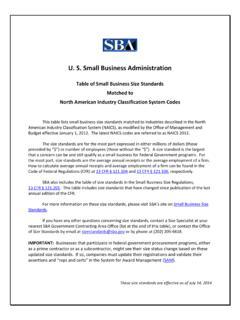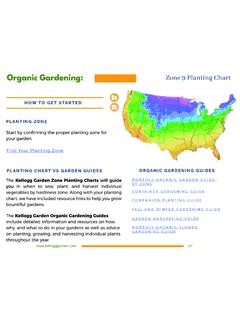Transcription of Fertilizer Recommendations for Soybean
1 This guide provides Recommendations on how to manage soil fertility with Fertilizer and lime application to optimize the profitability of Soybean production in Nebraska has expanded signifi-cantly over the past twenty years and is second only to corn in area planted, at almost five million acres. In general, the Fertilizer requirements for Soybean are typically less than for other crops such as corn, sorghum and wheat. Yield increases of Soybean in Nebraska are observed mostly with nitrogen and phosphorus application. Generally, soils that have been fertilized for corn should have adequate fertility for Soybean production. In eastern and central Nebraska, lime application may be required to optimize yield potential on some soils. In central and western Nebraska, lime-induced iron chlorosis may often be a concern.
2 In rare instances, soil tests may indicate the need for potassium or zinc soil pH between and will enhance the availability of nutrients such as nitrogen and phosphorus, as well as microbial breakdown of crop residues. Symbiotic nitrogen fixation in Soybean root nodules by Bradyrhizobium japonicum bacteria is optimal between pHs of and , although the bacteria will function at pH levels as low as A lime requirement test (buffer pH) is routinely performed during soil test procedures on soils with a pH of or less. Lime application is likely to be profitable on soils where the 0- to 8-inch surface pH is or less, and where the subsoil pH is or less to a depth of two feet or more. For soils with surface pH values greater than or subsoils with pH 6 or greater, lime application is less likely to be with the soil pH test, a lime requirement test (buffer pH) is routinely performed on soils with a pH of or less.
3 Based on this test, the quantity of lime material necessary to raise the soil pH to in the surface 6 to 7 inches is profitability of lime application for Soybean pro-duction is influenced by how long the land can be farmed. Lime application will rarely provide a payback in one year, and four to seven years may be required for full payback. Since lime is relatively insoluble, soil pH will gradu-ally increase during the first 6-18 months after application. Applying less lime more frequently may be more profitable if land tenure is uncertain and for no-till situations. Site- specific lime application also may be a profitable option for Soybean , applying lime only to those areas where the surface pH is less than present in Soybean root nodules will fix nitrogen from the atmosphere, normally supplying most or all nitrogen (N) needed by the plant.
4 Soybean grown on land where well nodulated Soybean has been grown in recent years will prob-ably not require inoculation; however, if Soybean has not been raised previously or if there is any question about the presence of Rhizobium bacteria, inoculation is Soybean plant will effectively utilize soil residual nitrate and nitrogen mineralized from soil organic matter. Soybean will obtain 25 to 75 percent of plant nitrogen from the soil, with the balance supplied from symbiotic fixation. In some situations, nitrogen supplied by fixation may not fully meet crop needs. Before active nodules form on roots, all nitrogen will be sup-plied to the plant from soil. Under some soil conditions (low pH, low organic matter, low residual nitrogen, large amounts of residue), the supply of nitrogen from soil and nodules may not be adequate.
5 In these cases, Soybean yield can be increased by applying nitrogen Fertilizer . The need for nitrogen Fertilizer cannot be predicted by soil tests. Nitrogen may be needed if one or more of the following conditions are present: The Soybean crop does not have a uniform dark green color throughout the field (but is not chlorotic light green to yellow interveinal tissue with dark green veins due to wet, saline or calcareous soil conditions). Soils are acid with a pH of less than Soils are light colored, low in organic matter, eroded or compacted. Soybean has not been grown in the field for some time, or the field has not had adequate nitrogen applied on grain crops. Active nodules (dark pink center) are absent from roots or few in number.
6 The Soybean crop was not inoculated and deficiency symptoms are nitrogen deficiency is suspected based on the above condi-tions, apply 80 to 100 pounds of nitrogen per acre. Ideally, nitrogen application should be tested first on a small part of the field to see if this corrects the problem before fertilizing the entire field. Excessive nitrogen availability at early growth stages can result in lodging and yield reduction. Fertilizer can be applied as late as early pod fill and still be effective, provided rainfall or irrigation occurs soon after application. KLT ELT KLT KLT KFSBOPFQV LC B?O>PH> FK@LIK UQBKPFLK KPQFQRQB LC DOF@RIQROB >KA >QRO>I BPLRO@BPG859(Revised August 2006) Fertilizer Recommendations for SoybeanRichard B. Ferguson, Extension Soils Specialist; Charles A.
7 Shapiro, Extension Soils Specialist; Achim R. Dobermann, Extension Soil Fertility Specialist; and Charles S. Wortmann, Extension Nutrient Management SpecialistSoybean demand for nitrogen and water is greatest dur-ing pod fill, particularly after the R-3 growth stage. Recent research in Kansas has shown that in fields with an already high yield potential (greater than 60 bushels per acre), an application of 20 to 40 pounds of nitrogen per acre at the R-3 stage can increase yield by 5 to 10 percent. Research and demonstration efforts in Nebraska have found this increase to be inconsistent and difficult to predict. Of ten trials conducted between 1997 and 2001, two showed a significant yield increase to supplemental nitrogen (one at average yield levels of 64 bu/acre, the other at average yield levels of 48 bu/acre).
8 All but one of the non-responsive sites had average yield levels of less than 60 bu/acre. Interested producers are encouraged to investigate this practice on their most productive irrigated fields by using replicated treatment strips to evaluate the benefit of supplemental nitrogen on their farms. Response to nitrogen application at R-3 to R-4 growth stages will be enhanced by irrigation. Thus, response to late season nitrogen application under dryland conditions is less can produce maximum seed yield with relatively low levels of available phosphorus (P) in the soil. Phosphorus application is not likely to increase seed yield at soil phos-phorus concentrations above 12 ppm P (Bray-1 test). Figure 1, based on the experience and judgment of University of Nebraska soil scientists, illustrates the approximate percent of potential yield attainable, and the probability of a yield increase with phosphorus fertilization at various soil phos-phorus phosphorus levels usually are not an issue when making Recommendations for phosphorus fertilization.
9 In many areas of Nebraska subsoil phosphorus levels may be somewhat higher than those found in much of the Midwest, explaining the lack of response to phosphorus fertilization on some soils. Table I provides phosphorus Fertilizer recom-mendations based on Bray-1 and Olsen phosphorus tests. The Olsen P test is used on soils with pH of or greater. The Mehlich-3 phosphorus test may be used by some analytical labs in Nebraska. Results from the Mehlich-3 test are interpreted equivalent to Bray-1 recommended rates should be followed annually for four years, after which the soil should be tested again and rates adjusted accordingly. Soybean will most often be grown in rotation with corn in Nebraska, which will have a higher critical level for soil test phosphorus.
10 Consequently, producers using a corn/ Soybean rotation will most likely want to maintain soil phosphorus at a higher level than if grow-ing Soybean alone; however, the probability of an economic yield increase to phosphorus fertilization of Soybean at Bray-1 P soil test levels above 12 ppm is low. With an average Bray-1 P level of 12 ppm in a field, there likely will be areas within the field that test above and below 12 ppm. Site-specific phosphorus application to lower-testing regions may be a more profitable approach, although identifying lower phosphorus regions within fields is problematic. Phosphorus Fertilizer can be broadcast applied and in-corporated into the soil prior to planting. With low soil test phosphorus levels, band application of Fertilizer is more ef-ficient than broadcasting.





